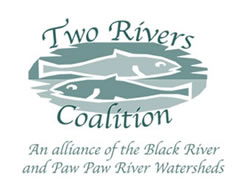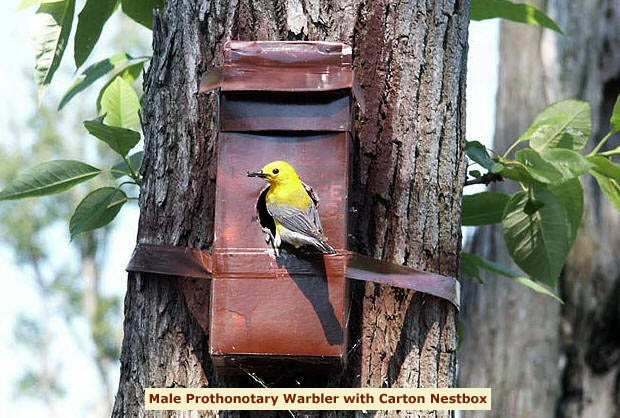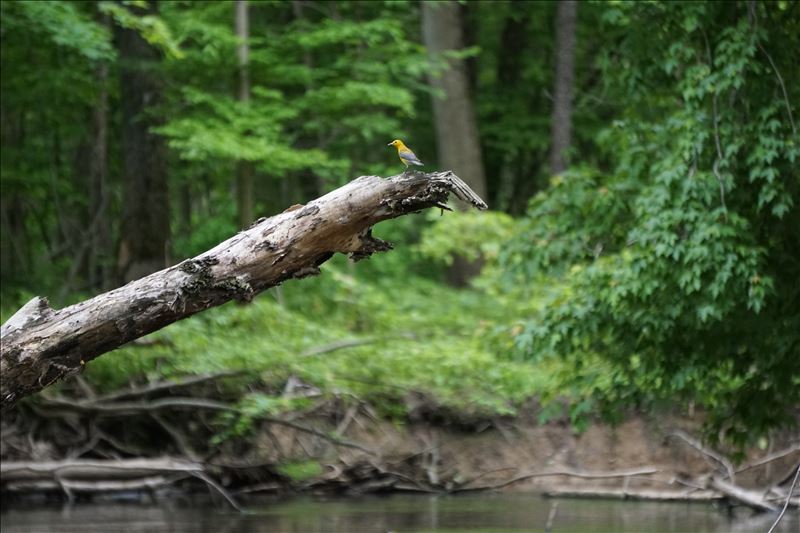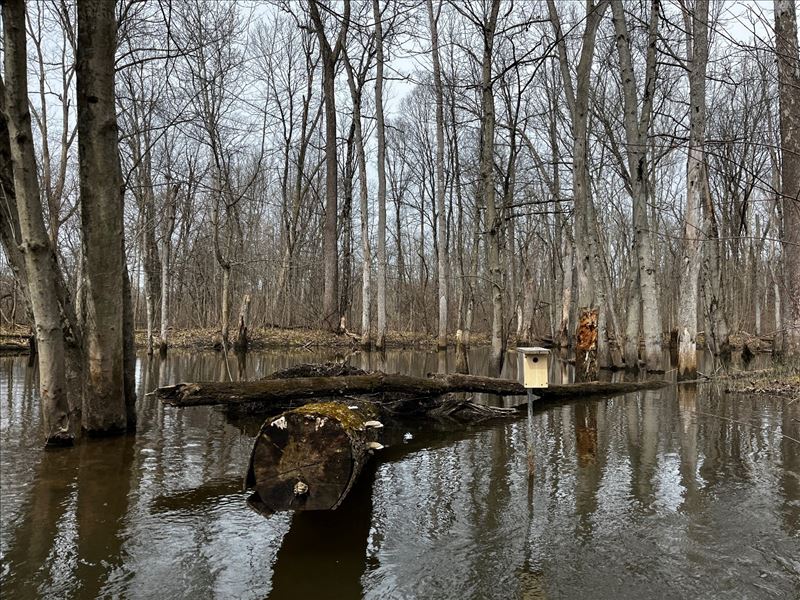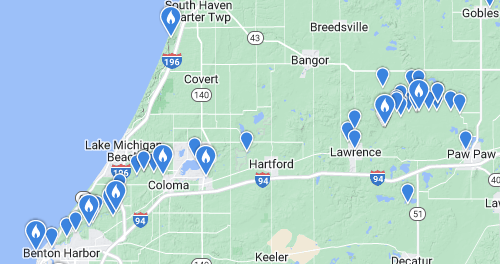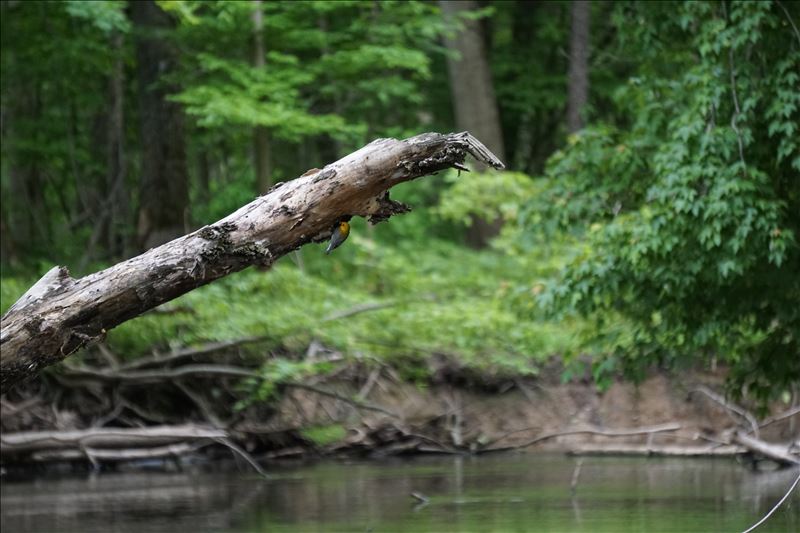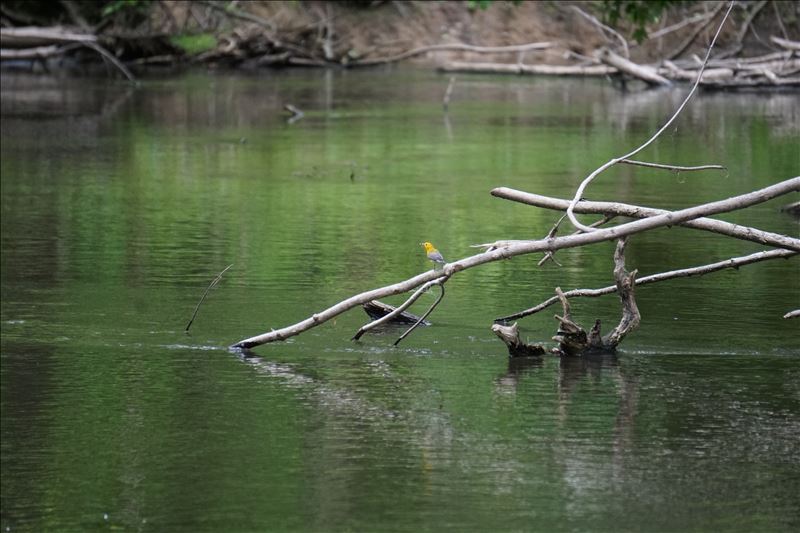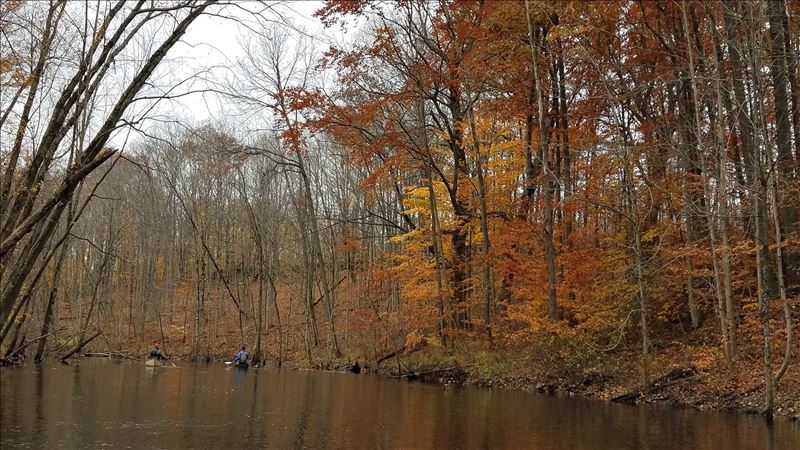Home>Let It Flow
Partnering with Prothonotary Warblers
In the late 1990’s my wife and I were paddling a winding water trail on the Cache River in southern Illinois when we noticed a bright yellow bird landing on a milk carton nest box mounted to a tree along the river’s edge. This was the first time I can recall seeing a prothonotary warbler and it made a memorable impression that I have not forgotten, even after many of the details from that trip have faded away. After several hours on the river, we had many more prothonotary warbler sightings as these milk cartons were scattered along the winding water trail to encourage nesting of this cavity nesting warbler (one of only two warblers that use nest cavities). We began to recognize its loud piercing sweet-sweet-sweet… (5-12 times) calls as we paddled the Cache River with these beautiful birds.
Fast forward to 2020 and I was paddling solo down the Paw Paw River when I noticed a brightly colored prothonotary warbler using a cavity in an old, dead tree over hanging the river. My mind immediately went to the Cache River, its milk carton nest boxes, and my overall enjoyment of that experience from so long ago. In the past 10-15 years I have paddled all the Paw Paw River, the Kalamazoo River, and many other rivers in southwest Michigan. In all those paddle trips, I could not remember seeing a prothonotary warbler before that day on the Paw Paw River which seemed odd.
After some research, I found that these warblers are only found in healthy floodplain forest or wooded swamps. The warblers are not abundant in Michigan as it is in the upper limit of their breeding range. They are also only present along Michigan’s rivers during the breeding season from about April through July. Maybe after all that paddling in southwest Michigan, I had just not been lucky enough to check all the necessary boxes. Never-the-less, being a volunteer lead paddler for events at Two Rivers Coalition, I began to develop a plan to try and recreate my Cache River experience for paddlers of the Paw Paw River.
Two Rivers Coalition has a mission to conserve, educate and advocate for the Paw Paw and Black River Watersheds and providing paddling events where we seek out and show the public these beautiful birds seemed like a fun and rewarding paddling experience. Not only would we get to enjoy the river with the public, we would get to show them one of its more colorful inhabitants. To make it more reliable and easier to find the prothonotary warbler, we would create some nest boxes and mount them in areas with prothonotary warblers. Then each season we could lead a paddling event to the nest boxes for everyone to see, hear and just simply enjoy these amazing warblers learning a little bit about this resident warbler.
Unfortunately, after two years, we have yet to get a prothonotary warbler to nest in our man-made boxes. We have had some trial and error on nest box placement and entry hole size, but we continue to work toward a successful nesting. In that time frame, I have done more reading about these warblers and learned that they are considered indicator species for healthy floodplain forest. Their presence in the Paw Paw River Watershed was telling us that we had healthy floodplain forest. I got to thinking that this could be useful in allowing Two Rivers Coalition to monitor and better understand where some of the healthiest parts of the watershed are, where protection is needed, and where restoration efforts might help.
With that our partnership with the prothonotary warbler further developed beyond the paddling event. It has taken on another promising phase as we want to better understand how these warblers can help us in our monitoring of the watersheds. By asking for the public to participate in community science to look for these warblers during the breeding season and recording their observations in eBird, we can as a community create more accurate maps of their presence which helps us understand the underlining habitat. The prothonotary warbler is a species of special concern in Michigan and is included in the state’s Wildlife Action Plan Species of Greatest Conservation Need List. The community science data could be used to potentially support conservation efforts in our watersheds given the importance of this warbler.
That is more or less how the Two Rivers Coalition prothonotary warbler partnership started and continues to evolved. The partnership is akin to the river it started on with its many meanders mirroring our learnings as we proceed to better understand this partnership. During my studies of the prothonotary warbler, I learned that my original encounter with them on the Cache River with the milk cartons was part of a study lead by Jeff Hoover. His studies provided data to support the indicator species status of the prothonotary warbler regarding floodplain forest. Listed below are some of the take aways from Hoover, Jeffrey P. 2009. “Prothonotary Warblers as Indicators of Hydrological Conditions in Bottomland Forests.” In Proceedings of the Fourth International Partners in Flight Conference: Tundra to Tropics, edited by Terrell D. Rich, Coro Arizmendi, Dean W. Demarest, and Craig Thompson, 128–137. Partners in Flight.
- Indicator species provide important information on habitat quality and the ecological integrity of ecosystems. Indicator species have been studied to sound the alarm when ecosystems are degraded or threatened, but they also may be used to measure the success of habitat management and conservation activities.
- There are a number of characteristics that add to the value of a species as an indicator. These characteristics include providing an early warning of habitat degradation or loss of ecosystem integrity, indicating the cause of the problem and not just that a problem exists, providing assessment over a wide range and intensity of degradation, and being cost-effective to monitor and relatively easy to study. In addition, an indicator species may be particularly useful if it is emblematic of, or strongly associated with, a particular habitat, tightly linked to ecosystem processes, and representative of how other ecologically similar species are being affected. Even though indicator species have been used to sound the alarm when ecosystems are degraded or threatened, they also may be used to measure the success of habitat management and conservation activities.
- Prothonotary Warblers (Protonotaria citrea) preferentially breed in forested wetlands in the eastern half of the U.S. and are therefore an emblematic species of bottomland forest ecosystems. Prothonotary Warblers prefer to nest over water, a preference thought to be associated with food (i.e., insect) availability and selective pressure from terrestrial nest predators (e.g., raccoons). Therefore, these warblers are threatened not only by habitat loss and habitat fragmentation, but also by the channelization of streams and the subsequent cascade of events that degrade hydrological processes associated with off-channel forested wetlands.
- Habitat specificity, a tight link to hydrological processes, and the fact that they can be studied in great detail during the breeding season make Prothonotary Warblers well-suited to be an indicator species.
- The interplay of topography and hydrology creates and maintains habitat complexity and promotes high levels of biodiversity. Intact bottomland forest ecosystems are important habitats for many species of bird and are especially valuable because they support a high diversity and density of breeding Neotropical migratory birds.
- The number of Prothonotary Warblers using particular forested wetlands can vary dramatically across years in association with hydrological processes. Warbler densities increased or were maintained at high levels in forested wetlands where hydrological processes had been either restored or not degraded. This positive effect of hydrological conditions on the density of warblers is the result of a chain of events that begins with forested wetlands retaining their water for much of the breeding season (April-July). The presence of relatively deep water in these “higher-quality” wetlands leads to decreased rates of nest predation which, in turn, lead to increased productivity. The more successful prothonotary warblers are, the more likely they are to return to the same breeding location the following year.
- The results from my research on Prothonotary Warblers support the conclusion that conservation practices that conserve or restore the integrity of forested wetlands, are benefiting local populations of breeding birds. Habitats that promote low or reduced rates of nest predation and high annual fecundity, such as the deeper-water areas of forested wetlands, are important to local population dynamics and may be critical to the maintenance of populations over larger geographic scales.
In another study, Cooper and others (2009) reported that, “the nature of the responses shown by prothonotary warblers to anthropogenic and natural perturbations suggests that this species can serve a valuable role as an indicator of floodplain forest ecosystem integrity. Usually abundant in functioning floodplain forests, this species is less common in floodplain forests that do not flood regularly due to altered hydroperiod. Prothonotary warblers were largely unaffected by timber harvests designed to mimic natural disturbances but were influenced by both the presence and timing of flooding, an integral ecological process in these ecosystems, and fragmentation which exposes interior forest birds to brood parasites.”
As Two Rivers Coalition enters its third year of this partnership, we are excited to learn more about these emblematic floodplain forest warblers and how they can help us meet our goals of conservation, education, and advocacy of these watersheds. We hope that this is the year that we get warblers to use our man-made nest boxes and that we get the opportunity to share this experience with the public to educate them about this important indicator species of healthy floodplain forest. Even without a successful nesting we know paddlers are seeing the nest boxes, asking questions about them, and in the end learning about these warblers and hopefully the habitat they need to survive. Educating and advocating for these watersheds is what Two Rivers Coalition aspires to do and we think this is a good opportunity for that work. We also want to help conserve the ecologically important habitat in our watersheds and hope we can add to the eBird database to show where these species of special concern are using the wetland forests in the Paw Paw and Black River watersheds. By further documenting where these warblers are present in the watershed, we hope that can lead to further conservation efforts benefiting the warblers and the overall watershed. Please joins us in the partnership.
Additional Resources:
- Columbus Audubon: The 2009 Quest for Nesting Prothonotary Warblers – Columbus Audubon
- Cooper, R.J., Wood, L.A., Gannon, J.J. et al. Effects of timber harvest and other factors on a floodplain forest indicator species, the prothonotary warbler. Wetlands 29, 574–585 (2009). https://doi.org/10.1672/08-139.1
- The Cerulean, Summer 2016: Cerulean-Summer-2016.pdf (ohiobirds.org)
- EBird: Prothonotary Warbler – eBird
- EPA Healthy Watersheds: Healthy Watersheds Protection | US EPA
- Going for the Gold Presentation: Going for the Gold Three Decades of Prothonotary Warbler Husbandry by Dan Best and Rachel McKinney – YouTube
- Hoover, Jeffrey P. 2009. “Prothonotary Warblers as Indicators of Hydrological Conditions in Bottomland Forests.” In Proceedings of the Fourth International Partners in Flight Conference: Tundra to Tropics, edited by Terrell D. Rich, Coro Arizmendi, Dean W. Demarest, and Craig Thompson, 128–137. Partners in Flight.
- Michigan Natural Features Inventory (MNFI): Protonotaria citrea (Prothonotary warbler) - Michigan Natural Features Inventory (msu.edu)
- NestWatch: NestWatch | Prothonotary Warbler – NestWatch
- Nature Serve: Protonotaria citrea | NatureServe Explorer
- Peoria Audubon, Dr. Jeff Hoover: Peoria Audubon Society - Jeff Hoover: Warbler Research
- Sialis: All About Prothonotary Warblers - species bio (sialis.org)
- Dr Christopher Tonra: The Tonra Lab of Avian Ecology - Home (christophertonra.com)
- Two Rivers Coalition: Two Rivers Coalition: An Alliance of the Black River and Paw Paw River Watersheds
- Lawrence Walkinshaw, Nesting Studies of the Prothonotary Warbler: Nesting Studies of the Prothonotary Warbler on JSTOR
